

 | ||
 | ||
Vol. 12 (1): June 2009 | ||
Croatia / Greece / Italy / Mauritania & Western Sahara / Spain / Turkey
Croatia
|
 | 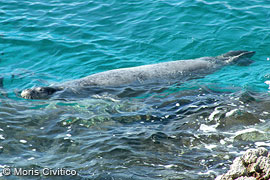 | |
| The 14.02.2009 sighting near Cape Kamenjak – Verudela, Pula. Courtesy GSM. | The 8.03.2009 sighting at Kamenjak-Premantura. Courtesy GSM. |
A second sighting occurred on 08.03.2009 at Kamenjak-Premantura and was photographed by Moris Civitico of Pula. The encounter, reports Antolovic, lasted several minutes, and was also witnessed by diving members of the GSM from Trieste, Marta Piccoli and Gianni Pecchiar. Piccoli reported afterwards that the seal “was very quiet, did not show fear and watched her with curiosity.”
Sighting 14.02.2009 at Cape Kamenjak – Verudela, Pula, Croatia, filmed by Silvano Sergo. Courtesy GSM.
Sighting 08.03.2009 at Cape Kamenjak – Premantura, Pula, Croatia, filmed by Moris Civitico. Courtesy GSM.
Under bright but overcast skies, Mediterranean monk seal pup ‘Artemis’ was released into the protected waters of the National Marine Park of Alonissos, Northern Sporades on 11 April. After a brief ceremony attended by local well-wishers, visiting dignitaries and supporters of MOm – the NGO spearheading monk seal conservation in Greece – Artemis was placed in a transport cage and put aboard the research vessel IFAW-Odyssia, for the 2.5 hour journey to Piperi, an island in the core zone of the 2200 sq km Marine Park. The IFAW-Odyssia was escorted by the patrol boat of the Marine Park’s management authority.
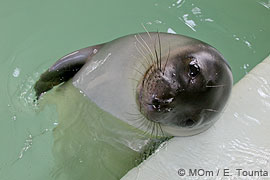 | |
| Artemis. |
Jeny Androukaki, Head of the Monk Seal Rehabilitation Centre at Steni Vala, Alonissos, later reported that Artemis quickly became acclimatized to her new surroundings. After briefly exploring the small beach where she was released from the transport cage, the seal was quickly drawn to the water and the small waves breaking on the shingle. She then began swimming and diving, displaying, said Androukaki, several darting movements suggesting that she was chasing fish.
Courtesy of the UK’s Sea Mammal Research Unit, Artemis was equipped with a mobile phone-based tracking device which is hoped will provide various data on the seal’s position and dive depths. A similar device, placed on monk seal pup Viktoria last year did not, however, function, and was deemed to have been faulty by the SMRU.
Following some initial anxiety among the researchers, Artemis’ tracking device began to function as intended, providing basic information via SMS messaging on the seal’s whereabouts, first at Piperi, the release site, and later on at various locations within and outside the boundaries of the Park. MOm and SMRU researchers are said to be pleased with the satellite-tracking and time-depth recording data yielded so far via data link. In one instance, Artemis was recorded diving to a depth of 117 m.
The release ceremony at Steni Vala was attended by Sophia Staikou, President of Piraeus Bank Group Cultural Foundation and Head of Corporate Social Responsibility. Piraeus Bank has been a long-time supporter of MOm’s monk seal conservation efforts in Greece through its CSR programme.
For in-depth coverage of Artemis’ rescue, rehabilitation and release, please turn to our Cover Story, Artemis Diary.
Artemis’ release at Piperi, 11.04.2009. Courtesy MOm.
Monk seal pup 'Artemis’ in rehabilitation (I), 11 January 2009; MOm Rescue Centre, Alonissos, Northern Sporades Marine Park. Courtesy MOm.
Monk seal pup 'Artemis’ in rehabilitation (II), 11 January 2009; MOm Rescue Centre, Alonissos, Northern Sporades Marine Park. Courtesy MOm.
Tragically, orphaned monk seal pup 'Artemis' has been found dead on Skiathos in the Northern Sporades.
The body was discovered on 14 May 2009, floating in Skiathos harbour. It was transferred the same day to Athens for necropsy, conducted by Prof. Dr. Thijs Kuiken, a veterinary pathologist specialising in marine mammals from Erasmus University, Rotterdam.
The necropsy established that Artemis was in excellent nutritional condition and overall health, with a body weight normal for her age, MOm subsequently reported. There was clear evidence that the seal had died as a result of drowning – most probably the result of becoming entangled in fishing gear.
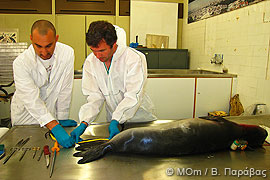 | |
| Veterinary pathologist Prof. Dr. Thijs Kuiken (r) and Alexandros Karamanlidis (l), a MOm biologist, preparing to conduct the necropsy at the University of Athens. |
Further information on Artemis' state of health prior to her sudden death could be gleaned from data retrieved from her satellite tag, which showed her progressively achieving greater confidence both in mobility and diving. Though at first she remained close to her release site at Piperi in the core zone of the National Marine Park of Alonissos, Northern Sporades, she eventually travelled more than a 100 nautical miles, straying beyond the borders of the Park; her dives exceeded 150 m.
“Although the young seal quickly adjusted to its natural environment,” says Vangelis Paravas, Conservation and Policy Coordinator of MOm, “the harsh but unavoidable fact is that Artemis ultimately also had to face the reality of surviving in the wild, just as the rest of the remaining monk seals in the Mediterranean Sea.”
Data gathered by MOm through its EU-funded project on seal-fishery interactions indicates that lethal entanglement in fishing gear is the most serious cause of death among immature monk seals. The organisation is developing proposals aimed at lessening monk seal mortality stemming from such interactions, whilst promoting sustainable coastal fisheries.
Further information can be obtained from the MOm press release:
A sad last message from Artemis [PDF  120 KB]
120 KB]
“Concrete conservation actions for Mediterranean Shag and Audouin’s Gull in Greece including the inventory of relevant Marine IBAs” is the title of a new EU LIFE project launched in January this year. This 4-year project aims to achieve a significant improvement of the Mediterranean Shag’s (Phalacrocorax aristotelis desmarestii) and Audouin’s Gull (Larus audouinii) conservation status in Greece, by implementing concrete conservation actions in 17 Greek SPA sites, according to the guidelines and priorities identified by the International Action Plans for the two species. An overall improvement of their conservation status will be further enhanced by the identification of marine Important Bird Areas (IBAs), through a well organised campaign following the relevant guidelines of the European Commission and instructions of BirdLife.
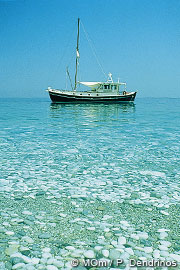 | |
| MOm's research vessel, IFAW-Odysseia. |
The project partnership brings together NGOs and research institutes with significant experience and expertise in conducting nature conservation projects, and in implementing concrete conservation actions and related surveys. Hellenic Ornithological Society (HOS), the Greek Birdlife partner, in collaboration with SPEA (the Portuguese BirdLife partner), the Hellenic Society for the Protection of the Monk Seal (MOm), the Hellenic Centre for Marine Research (HCMR), and the Ionian Technological Institute (TEI) are collaborating to promote the two species’ conservation in 17 Greek SPA sites, designated specifically for them. In this effort, the experience and expertise of the BirdLife partnership, especially of the RSPB, will play a significant role, thus providing a harmonised approach to the planning and implementation of the project actions.
MOm is responsible for the field research and awareness campaign activities in the northern Aegean and its research vessel “IFAW-Odysseia” will be used as the base for the fieldwork. During the project data on other seabird species, cetaceans and on the monk seals will be collected in order to achieve (through compilation with data on the distribution of pelagic fish populations, oceanographic and sea productivity parameters etc.) a more comprehensive knowledge on the marine ecosystem in Greece. Some of the key expected results of this project are:
Overall, the project’s activities are expected to constitute a significant step towards the conservation of marine and coastal environments in Greece. – Panos Dendrinos, MOm.
Web visitors from around the world are now able to learn more about the Mediterranean monk seal and MOm’s conservation actions in Greece, through the English version of www.mom.gr, and also through MOm’s page and group on Facebook.
In an effort to raise the necessary funds for these conservation actions, MOm has also launched a Monk Seal Adoption programme; further information is available on the website. – Danae Protopapa, MOm.
On 4 March 2009 the Greek Ministry of Environment and Public Works signed a joint ministerial decision, which advances the formal establishment of the northern part of Karpathos and Saria islands in the eastern Dodecanese, as a protected area under the Greek law. The area is designated as the “Eco-development area of Olympos, Karpathos”, and includes various restrictions and regulations based on specific zones on the terrestrial and marine environment. The size of the protected area is over 150 sq km, of which 52 cover the surrounding sea.
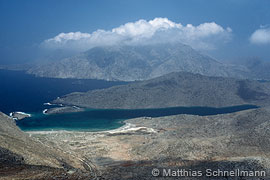 | 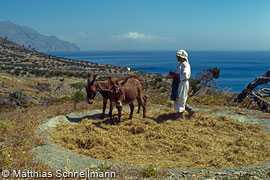 | |
| The northern tip of Karpathos, and beyond, Saria. | The traditional way of life is still practiced in some areas. |
Northern Karpathos and the surrounding islets provide shelter for one of the most numerous breeding colonies of Monachus monachus in the Mediterranean Sea. Many endemic and protected flora and fauna species are also distributed in the area, contributing to its diverse and rich natural environment. Additionally, the cultural heritage and the traditional architecture of the island are unique within Greece.
MOm has been conducting research and conservation actions in Karpathos since 1995. In 1996 North Karpathos and Saria islands became part of the EU Natura 2000 network. During 2000 MOm conducted a Special Environmental Study, proposing the establishment of the area as protected, which was strongly supported by the local community of the island. In 2003 the Management Body was established, and since then it has been the responsible institution for the management and conservation of the area. However, the formal establishment of legal measures in the area, the designation of its boundaries and regulations are still pending, since the joint ministerial decision has not been signed as yet by the other involved ministries. – Vangelis Paravas and Stella Adamantopoulou, MOm.
Mediterranean (Monk Seal) Diet (part I)
 | |
|
|
As part of the LIFE-NATURE project “MOFI”/ Monk Seal & Fisheries: Mitigating the Conflict in Greek Seas, the feeding habits of the Mediterranean monk seal were examined through stomach content analysis, the first study of its kind. The research began in January 2006 and was completed in March 2009, in collaboration with the Zoology Department of the University of Aberdeen. A total of 24 stomachs, which were collected during necropsies conducted by MOm’s biologists from dead animals found stranded in different areas of coastal Greece during the past 15 years, were sent to Scotland for analysis. The results of the three and a half year research indicate that the Mediterranean monk seal is an opportunistic predator with wide dietary preferences, which include benthic, demersal and benthopelagic fish species along with cephalopods – especially octopus, which is an important component of its diet. Details of the analysis will be presented in the Final Research Report of the project in July 2009.
Mediterranean (Monk Seal) Diet (part II)
Additional data on monk seal feeding preferences will be obtained by the application of stable isotope analysis in collaboration with the Okanagan Regional Chemical Analysis Centre of the University of British Columbia in Canada. The aim of the analysis is to trace the entire range of trophic levels on which monk seals feed, while at the same time distinguishing between different sources of possible prey species. This technique is based on Carbon and Nitrogen stable isotopes found in the tissues of species preyed upon by monk seals, compared to the same stable isotopes found in monk seal tissues. Thus, 45 different samples collected by Mom’s biologists during necropsies, along with 35 samples of different marine species, including fish, crustaceans, cephalopods and algae, were sent to Canada to undergo analysis. The results are due in the coming months. – Vangelis Paravas and Stella Adamantopoulou, MOm.
Also as part of the MOFI project, a revised Strategy for the Conservation of the Mediterranean Monk Seal in Greece, and an Action Plan for its implementation, has been formulated, building on the foundations laid by the former official Greek Strategy, which had been a joint effort by MOm and Archipelagos. The document includes a full review of the former Strategy, capitalising on its achievements and learning from its weaknesses and failures.
The long-term goal of the strategy is: “to assure the recovery and long-term viability of Mediterranean monk seals in Hellenic waters”. This goal is defined by the following 4 objectives: 1. Monk seal conservation established as a national objective, 2. Knowledge of monk seal ecology and biology important for the conservation of the species is secured, 3. Areas containing critical monk seal breeding habitat in Greece are identified, legally protected and organised into a functional network of protected areas in which monk seal numbers are stable or increasing and 4. Monk seal conservation measures are legally adopted and effectively implemented throughout national waters, so that threats are diminished and monk seal populations and habitat nationwide are not lost.
The Strategy also identifies the recommended actions to meet the 4 objectives. All necessary and urgent actions to be taken are described within the Action Plan and listed in tabular form in the implementation schedule, where indicators of progress are also recommended.
The revised Strategy will be presented to the relevant stakeholders and authorities in an open meeting in June. The final document will be submitted to relevant Greek Ministries and the European Commission for formal adoption. It is hoped that its implementation might begin as early as this year, and that it will remain in place until its planned revision in 2015. – Vangelis Paravas and Stella Adamantopoulou, MOm.
The collection of data on monk seal-fisheries interaction, in collaboration with fishermen throughout the country, has been completed, with analysis also yielding concrete results, which are now being used and integrated into the Action Plan being formulated for the mitigation of such interactions. The Action Plan is expected to be presented by MOm in June in an open public meeting; this following a workshop with all relevant stakeholders. – Vangelis Paravas and Stella Adamantopoulou, MOm.
EndQuoteSea Serpents Likely to be Discovered Michael A. Woodley, Darren Naish and Hugh P. Shanahan have had published on Tuesday, March 24, 2009, in the new number of Historical Biology (2009), their groundbreaking paper, "How many extant pinniped species remain to be described?" Here is their press release on the contribution: ‘Three new large marine mammals, so-called sea-serpents, are extremely likely to be discovered according to researchers. In a paper published today, a team of scientists conclude that three new unusual species might await discovery, all of which may belong to the group of marine mammals known as pinnipeds. The best known pinnipeds are seals, sea lions and walruses. […] "While the low number of three possible new pinniped species matched our statistical expectations, there is a need for scepticism as all known pinnipeds are noisy animals with close ties to land", said Mr Woodley. "These pinnipeds would have to possess some exceptional characteristics, if they exist."
|
Mediterranean News continues with Italy, Mauritania & Western Sahara, Spain and Turkey...
Copyright © 2009 The Monachus Guardian. All Rights Reserved |